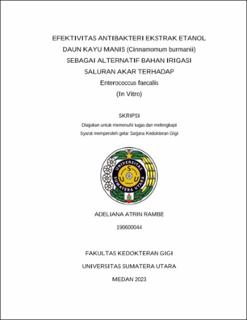| dc.description.abstract | Enterococcus faecalis is a facultative anaerobic gram-positive pathogenic
bacteria that is often found in root canals. Various irrigants to eliminate bacteria in
root canals include Sodium Hypochlorite (NaOCl), EDTA, Chlorhexidine, and
MTAD solutions, but all of these irrigants have weaknesses. Cinnamon leaves are one
of the natural ingredients that can be developed as an alternative to root canal
irrigation. This study aims to determine the antibacterial effectiveness of cinnamon
leaf ethanol extract (Cinnamomum burmanii) as an alternative root canal irrigation
agent against Enterococcus faecalis by finding the minimum inhibitory concentration
and minimum killing concentration of cinnamon leaves which can inhibit the growth
of Enterococcus faecalis. This type of research is a laboratory experiment with a post
test only control group design. As much as 500 grams of cinnamon leaves were
extracted by maceration method to obtain a thick extract.
The MIC value was determined using the dilution method by diluting the
extract in BHIB with a concentration of 100%, 50%, 25%, 12.5%, 6.25%, 3.125%.
Each concentration was taken 8 ml, added 100 μl as a bacterial suspension, vortexed
and incubated at 37oC for 24 hours. The turbidity of each tube was observed visually
and compared with the positive control. The tube that starts to look clear is KHM.
Then each concentration was vortexed and 100 μl was taken, dripped on a petri dish
and then poured on MHA media and replicated 3 times, then incubated at 37oC for 24 hours and continued with the calculation of the number of bacterial colonies using the
Drop Plates Miles Mesra method to determine the MIC value and KBM.
The results were tested using one way ANOVA and post hoc LSD tests to see
the antibacterial effect of the relationship between concentration groups of 100. The
results of research on cinnamon leaf extract (Cinnamomum burmanii) had an
antibacterial effect on Enterococcus faecalis with a significance value of p = 0.000 (p
<0.05 ) and a significant difference between the concentrations of 6.25%, 3.125%,
1.56% and 100%, 50%, 25%, 12.5% The conclusion of this study was that the MIC
and KBM of cinnamon leaf extract against Enterococcus faecalis were found to be 6,
25% and 12.5%. | en_US |

